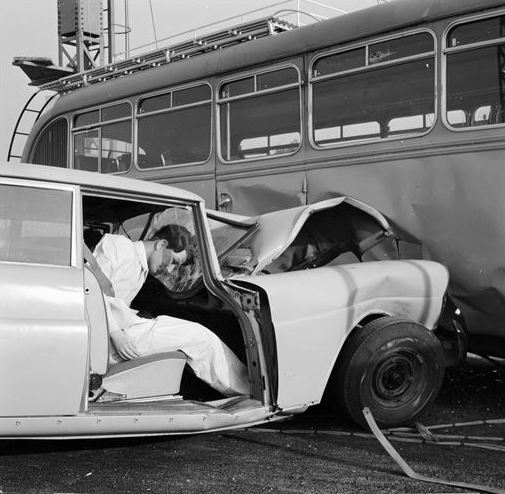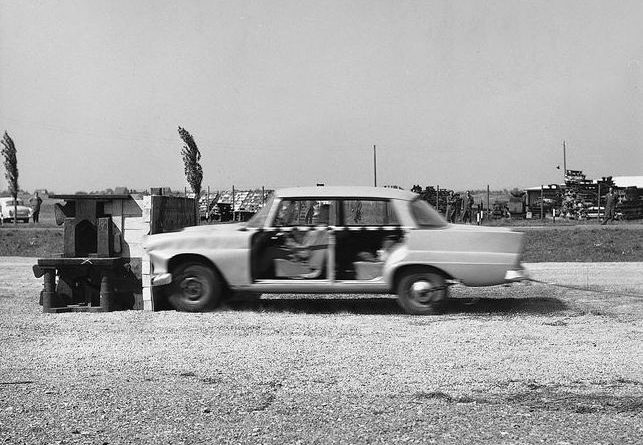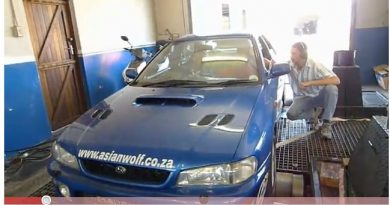75 years of protection for occupants and other road users from Mercedes-Benz
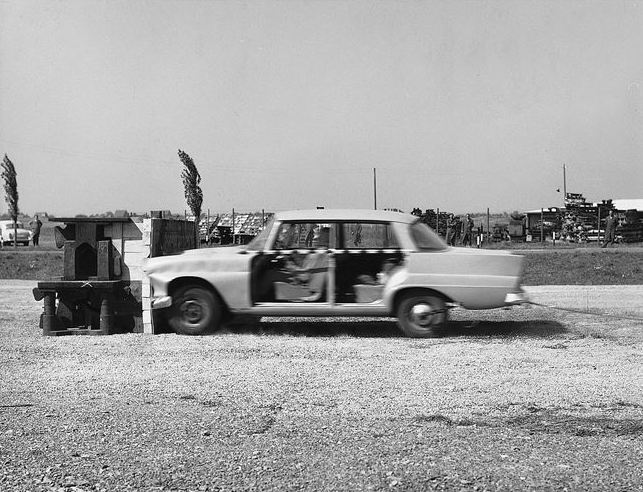
Stuttgart/Böblingen. An important chapter in the history of vehicle safety began 75 years ago when Béla Barényi joined the then Daimler-Benz AG, as the company was called then. To mark this anniversary, past and present members of the Mercedes-Benz safety development team, representing different eras of vehicle safety, met in the ‘Legendenhalle’ (Hall of Legends) in Böblingen.
“Pretty well everything”, responded the young engineer Béla Barényi boldly, when asked at his job interview what aspects of the current Mercedes-Benz vehicle range he would improve. Wilhelm Haspel, at that time a deputy board member of Daimler-Benz AG, was won over by the unconventional thinking of the 32-year-old Austrian and took him on, at the recommendation of the then head of testing in the bodyshell development area, Karl Wilfert. On 1 August 1939 Barényi took charge of the newly established safety development department.
So began an important chapter in the history of vehicle safety, 75 years ago, with the arrival of Béla Barényi at the then Daimler-Benz AG. Ever since those days, Mercedes-Benz has had an enduring influence on safety development. Many of the company’s innovations, particularly in the field of protection for vehicle occupants and other road users, have saved countless human lives over the years.
To mark this anniversary, Mercedes-Benz invited past and present members of the safety development team, representing different eras of vehicle safety, to the ‘Legendenhalle’ (Hall of Legends) in Böblingen. This enthralling look back over the first 75 years of providing protection for vehicle occupants and other road users brought together, amongst others, Professor Werner Breitschwerdt, Professor Ernst Fiala, Professor Guntram Huber, Dr Falk Zeidler, Hansjürgen Scholz, Dr Luigi Brambilla and Karl-Heinz Baumann. Some of them had known Barényi personally.
“Every innovation needs creative engineers who, like Barényi, are bold enough to question the status quo and to break new ground”, emphasised Professor DrThomas Weber, the Daimler AG Board of Management member responsible for Group Research and Mercedes-Benz Cars Development.
“Our declared aim at Mercedes-Benz is to retain and extend our role as trendsetters in the field of vehicle safety and, by doing so, to continue to improve road safety”, said Professor Rodolfo Schöneburg, Head of Vehicle Safety at Mercedes-Benz Cars. “And we are a long way off running out of ideas in this respect. We are currently, for example, concentrating on reducing the strain on the upper torso in a side-on collision.”
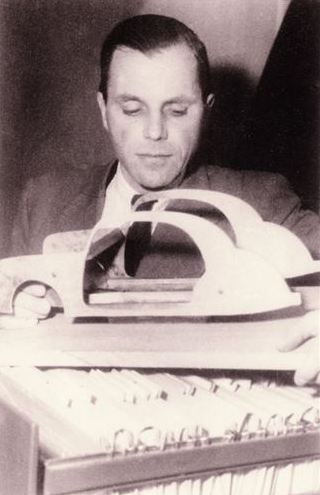
Béla Barényi: the father of safety
Visionary engineer Béla Barényi (1907-1997) worked for Daimler from 1939 to 1974. He initiated more than 2500 registered patents, many of them concerned with the principles of automotive safety. Among his inventions was the safety cell, protected by crumple zones.
Béla Barényi had groundbreaking ideas early on: even as a student in the 1920s, he was working on a design for a state-of-the-art car with a tubular backbone chassis and air-cooled boxer engine. From 1939 the engineer dedicated himself to improving passenger car bodies at Mercedes-Benz. This work resulted in a 1941 patent for an improved platform frame which, owing to its particular resistance against distortion, minimised “booming and shaking”.
From his studies of motor vehicles based on a cellular design, Barényi developed the concept of a stiff passenger cell with crumple zones.
Mercedes-Benz implemented the patent filed in 1951 for the first time on the W 111 model series (“Fintail”) of 1959. Crumple zones deform in an accident and absorb the kinetic energy from the collision in a controlled way. At the same time, a sturdy occupant cell protects the vehicle occupants. Since that time, this structure has become an established part of passenger vehicles worldwide.
Barényi’s “safety steering shaft for motor vehicles” also caught on. This technology was patented in 1963 and premiered as a complete safety steering system in the W 123 series of 1976, the predecessor to the E-Class. It took
28 years before his idea for a recessed windscreen wiper to protect pedestrians made its debut in the W 126-series S-Class of 1979.
“Always way head of his time”: reminiscences from those who knew Barényi
Professor Werner Breitschwerdtjoined Daimler-Benz AG as an engineer in 1953, was appointed Board Member for Development and Research in 1977 and became Chairman of the Board in 1983. From 1988 until 1993 Professor Breitschwerdt was a member of the supervisory board:
“I joined Daimler-Benz AG as an engineer in 1953 – so at a point when Béla Barényi was already celebrating one of the highlights of his working career: the patenting of the principle of the crumple zone. I got to know Barényi as someone whose sheer tenacity, more than anything else, made him stand out from the crowd. He had so many ideas and worked ferociously hard to ensure that his ideas were also acted upon. But he was also extremely fortunate in being able to work as freely as he did at Daimler-Benz. He was given a tremendous amount of freedom – and that was right and necessary at that time, in order to drive forward the important issue of safety. Just consider: Béla Barényi was coming up with his inventions in the post-war period. There were far more pressing issues in Germany at that time than automotive safety – these were just the early days of motoring, when people were driving bubble cars or other really small cars. And yet the engineers at Daimler-Benz were already working on improving the safety of future models. Barényi was always way ahead of his time.”
Professor Guntram Huber joined Daimler-Benz AG as a test engineer in 1959, becoming senior manager for passenger car body development in 1971. From 1977 until his retirement in 1997, Professor Huber was then the director of this area:
“At the time when Béla Barényi was making his important discoveries about automotive safety, there was no such thing as a crash test. Much of his work was based purely on theoretical principles – and on intuition. He would say how it had to be done, and he was right. That was the amazing thing about the man. Then, when I joined Daimler-Benz in 1959, we built the first test sled to use for safety tests: it was a really basic construction with one seat on it, operated by a pulley system. The crash zone in those early days was a pile of great big tins from the canteen kitchen. However, the first proper crash test with a vehicle soon took place, in the autumn of 1959, and we were just so full of admiration that Barényi’s crumple-zone concept worked precisely as he had calculated years earlier on a purely theoretical basis.”
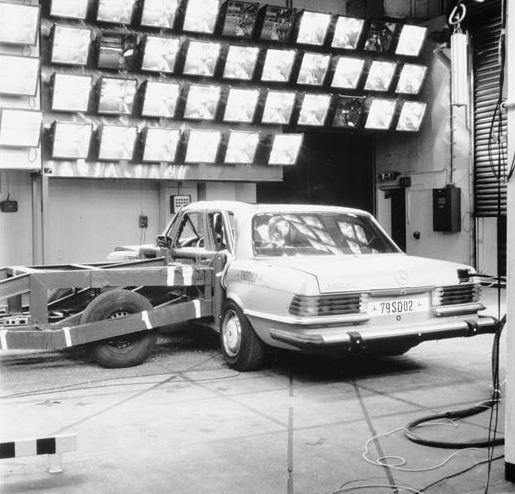
Dr Falk Zeidler worked from 1971 as a development engineer in the Mercedes accident research team, taking over as its head in 1989. In 2001 Dr Zeidler was appointed as Head of Product and Safety Analyses at the Mercedes-Benz Technology Center:
“I have rarely met an engineer who had such an enquiring mind, or was as dedicated and astute as Béla Barényi. I joined the accident research team at Mercedes-Benz in 1971, so was able to work with Barényi for about a year and a half until he retired. I can still remember very clearly: when we had completed the first analyses of real-life accidents and established in the process that, in a collision, the way the steering wheel moved back into the interior was often quite different from what we had seen in crash tests, Béla Barényi spoke to me and got me to explain in great detail what we had discovered in the accident analysis. The outcome of this conversation was ultimately a new patent from Barényi for further improvements to the safety steering system – a technology that then went into series production at Mercedes-Benz in 1979.”
Mercedes-Benz: setting the pace for safety
Mercedes-Benz is the pioneer of automotive safety. No other car manufacturer carries out such intensive research in this field and has brought so many crucial innovations onto the market. Ever since the invention of the motor car in 1886 Mercedes-Benz, together with its precursor brands, has been instrumental in the development of active and passive safety, setting one new benchmark after another in the process.
1900 Wilhelm Maybach develops the Mercedes 35 HP as a vehicle with exemplary road safety. Contributing factors are the long wheelbase, low centre of gravity, the engine bolted to the frame and the wide track.
1921 The Mercedes 28/95 HP is equipped with front-wheel brakes.
The other passenger car models from DMG (Daimler Motoren Gesellschaft)
and Benz & Cie. follow suit in 1923/24.
1931 The Mercedes-Benz 170 (W 15) is the first series production automobile with hydraulic braking system and independent front and rear suspension with swing axles.
1941 Patent No. 742 977 of 23 February 1941 for the platform frame developed by Béla Barényi.
1945 Béla Barényi develops the vehicle studies “Concadoro” and “Terracruiser” in this and the following years. Both studies are among the most important works leading up to the safety body with cell construction.
1949 Patent No. 827 905 of 23 April 1949 for the conical-pin safety door lock.
1952 Patent No. 854 157 of 28 February 1952 for the safety body with rigid passenger cell and crumple zones. Implemented in series production in the Mercedes-Benz W 111 model series in 1959.
1954 Single-joint pendulum axle with low pivot point in the Mercedes-Benz 220 a from the W 180 model series.
1958 Patent No. 1 089 664 of 2 July 1958 for the wedge-pin door lock.
Market launch as standard equipment in the “Fintail” models in 1959.
1959 Start of systematic crash testing and the use of dummies.
1959 Debut of the Mercedes-Benz W 111 model series (“Fintail”) with safety body, softened interior and wedge-pin door lock.
1961 Gradual introduction of disc brakes and dual-circuit braking system in the passenger car range.
1966 Hans Scherenberg and Béla Barényi draft the classification into active and passive safety that will remain valid until the introduction of PRE-SAFE®.
1967 Safety steering system with telescopic steering column and impact absorber across the entire Mercedes-Benz passenger car range
1971 An entire package of active and passive safety measures premieres in the Mercedes-Benz SL of the 107 model series: collision-safe fuel tank above the rear axle, thickly padded instrument panel, deformable or recessed switches and levers, four-spoke safety steering wheel with impact absorber and wide padded boss, newly developed wind deflector profiles on the A-pillars, large tail lamps with ribbed surface profile for extensive resistance to soiling.
1976 The “safety steering shaft for motor vehicles” patented by Béla Barényi in 1963 debuts in the Mercedes-Benz W 123 model series designed as a collapsible steering column.
1978 The second generation of the ABS anti-lock braking system debuts in the S-Class of the W 116 model series. Mercedes-Benz presented a first version not yet ready for series production as early as 1970. Starting in 1980 ABS is present in all model series.
1979 The Mercedes-Benz S-Class of the W 126 model series takes account of asymmetric frontal collisions with a forked-member structure of the front end.
1981 The world’s first driver airbag in the S-class. Mercedes-Benz has been engaged since 1968 in research into this supplementary restraint system. Starting in 1982 the driver airbag is available in all model series, the passenger airbag follows in 1987, the side airbag in 1995.
1982 Multi-link rear suspension in the Mercedes-Benz 190 (W 201).
1989 The new SL Roadster models (R 129) make their debut with a belt system integrated into the seats, plus a rollover bar that pops up automatically if the vehicle appears to be on the verge of overturning.
1995 Rain sensor and xenon lights in the Mercedes-Benz E-Class of the 210 model series.
1995 Series introduction of the Electronic Stability Program ESP® in the S‑Class Coupé of the 140 model series.
1996 Mercedes-Benz introduces the world’s first BAS Brake Assist system into series production.
1997 The sandwich floor of the W 168 model series A-Class causes the engine to glide under the passenger cell in a front-end collision.
1998 The windowbag premieres as an optional extra in the Mercedes-Benz S‑Class.
1999 Premiere of DISTRONIC proximity control.
1999 The ABC (Active Body Control) active suspension debuts in the CL coupé of the C 215 model series.
1999 Bi-xenon headlamps as standard equipment in the CL coupé of the 215 model series.
2001 Head/thorax side airbags in the SL Roadsters from Mercedes-Benz.
2002 PRE-SAFE® preventive occupant protection system in the Mercedes‑Benz S-Class, subsequently gradually introduced in the
other model series.
2003 Active light function with bi-xenon headlamps (E-Class 211 model series).
2005 The Integral Safety Concept of Mercedes-Benz combines the various systems of active and passive safety.
2005 Mercedes-Benz introduces various safety systems in the S-Class of the W 211 model series, for example, DISTRONIC PLUS, Brake Assist BAS PLUS and Night View Assist.
2006 The Intelligent Light System ensures perfect light distribution on the road in line with the driving situation (in the E-Class of the 211 model series).
2006 Premiere of the PRE-SAFE® brake as an optional extra in the CL coupé of the 216 model series.
2007 Premiere of Blind Spot Assist as an optional extra in the S-Class and CL‑Class.
2009 Premiere of ATTENTION ASSIST in the Mercedes-Benz E-Class of the 212 model series.
2009 Crosswind stabilisation debuts in the revised Mercedes-Benz S-Class of the 221 model series as an additional function of Active Body Control (ABC). The torque vectoring brake also premieres in series production.
2010 World premiere of Active Blind Spot Assist and Active Lane Keeping Assist in the CL-Class (C 216) and S-Class (W 221).
2011 Introduction of the radar-based assistance system COLLISION PREVENTION ASSIST in the B-Class (as standard).
2013 New assistance systems and systems with several new key functions (DISTRONIC PLUS with Steering Assist and Stop&Go Pilot, BAS PLUS with Cross-Traffic Assist, Active Lane Keeping Assist, Adaptive Highbeam Assist Plus, Night View Assist Plus, ATTENTION ASSIST) in the S-Class. New PRE‑SAFE® functions (PRE-SAFE® Brake, PRE-SAFE® PLUS, PRE-SAFE® Impulse), improved protection in the rear compartment (seat belt buckle extender, belt bag).
2013 Mercedes-Benz puts Car-to-X communication on the road.
2014 The QR code sticker, which gives the emergency services direct access to a vehicle-specific rescue card becomes available as a retrofit option for older Mercedes-Benz models as well.
2014 The enhanced assistance system COLLISION PREVENTION ASSIST PLUS system is introduced in the compact class model family. This extends the functionality of COLLISION PREVENTION ASSIST by the addition of autonomous braking to reduce the risk of rear-end collisions.
